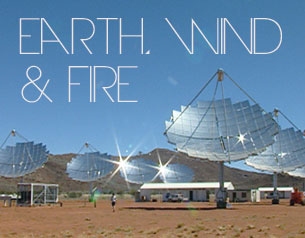Earth, Wind and Fire
With global warming dominating the political agenda, 'carbon footprint' and 'renewable energy' have become the latest buzzwords. But are renewable sources like these capable of sating the needs of the modern economy?
 With global warming dominating the political agenda, 'carbon footprint' and 'renewable energy' have become the latest buzzwords. Only renewable power, claim environmentalists, can enable us to maintain our current lifestyles without destroying the world. Tired of waiting for government action, states like California are taking the lead. In setting their own ambitious renewable energy targets, they're forcing industries to make the switch. But countries like Australia remain firmly wedded to coal. Is renewable energy capable of meeting the needs of a modern economy? We investigate.
With global warming dominating the political agenda, 'carbon footprint' and 'renewable energy' have become the latest buzzwords. Only renewable power, claim environmentalists, can enable us to maintain our current lifestyles without destroying the world. Tired of waiting for government action, states like California are taking the lead. In setting their own ambitious renewable energy targets, they're forcing industries to make the switch. But countries like Australia remain firmly wedded to coal. Is renewable energy capable of meeting the needs of a modern economy? We investigate.
In the flat outback of Southern Australia, geologists are digging the future. Three km underground is a layer of radioactive granite. For eons, the heat produced by radioactive decay was trapped beneath a layer of insulating clay. "We're looking at the hottest rocks on earth", states Dr Adrian Williams. By tapping this heat, Williams believes he can produce as much electricity as; "ten large coal-fired power stations".
But in Australia, schemes like this are funded primarily by the private sector. The government remains resolutely behind coal. In contrast, in California, Governor Arnold Schwarzenegger has introduced an ambitious plan to cut greenhouse emissions by promoting renewable energy. In just three years, 20% of its power will have to come from renewable energy. "California has taken the leadership in moving the entire country beyond debate and denial to action", boasts Schwarzenegger. "We are not waiting for problems to get worse."
The state gets half its renewable power from geothermal energy. "California is on a fault line. Their production of geothermal electricity is as a result of movement of plate tectonics", explains Ian McFarkabe, Minister for Tourism and Resources in Australia. This kind of technology would be impossible to reproduce in countries not located on fault lines.
According to enthusiasts, it's solar power that has the potential to save the world. "When you look on a global scale, it really is the big one", raves Dr David Mills, Chairman of AUSRA. China, India and America, the world's biggest polluters, all have huge deserts. The latest generation of solar panels are 1,500 times more effective than traditional ones. Rather than remaining fixed in one position, they track the sun.
Investors too are starting to latch on to the potential of solar power. Vonod Khosla made his first fortune investing in computers. He believes the world is on the brink of an energy revolution and has invested millions in solar power. "We hope to make a great rate of return as well as doing good for the climate". He claims his new power plant will produce some of the cheapest electricity in America.
But sceptics point out that solar power, even on a massive scale, can't provide electricity 24 hours a day. "There's this vague idea in the community that solar doesn't cost anything and can solve the problem", states Australian Prime Minister, John Howard. "It can't". Khosla aims to prove him wrong. He claims the technology to store heat and release it later so that solar stations can produce power constantly is just around the corner.
Renewable power schemes may still be in their infancy. Much of the technology remains unproven. But, as Vonod Khosla states; "Most industrial advantages come through innovation. Stick with coal, you won't have that".
Director: Bruce Belsham
FULL SYNOPSIS
Director: Bruce Belsham
